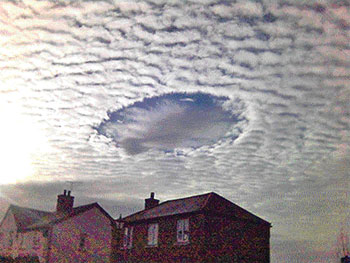Record depletion of Arctic ozone layer
Increased UV radiation in Scandinavia:
In early April ozone-depleted air masses extended from the north pole
to southern Scandinavia leading to higher than normal levels of
ultraviolet (UV) radiation during sunny days in southern Finland. These
air masses were due to move east over the following days, covering parts
of Russia and perhaps extend as far south as the Chinese/Russian border.
Such excursions of ozone-depleted air may also occur over Central Europe
and could reach as far south as the Mediterranean.

At an international press conference by the World Meteorological
Organisation (WMO) in Vienna April 5, atmospheric researcher Dr. Markus
Rex from Germany´s Alfred Wegener Institute for Polar and Marine
Research in the Helmholtz Association (AWI) pointed out that the current
situation in the Arctic ozone layer is unparalleled. Such massive ozone
loss has so far never occurred in the northern hemisphere, which is
densely populated even at high latitudes," AWI researcher Markus Rex
describes the situation.
The ozone layer protects life on the Earth's surface from harmful
solar ultraviolet radiation. Because of the low inclination angle of the
Sun, exposure to ultraviolet radiation is not normally a public health
concern at high northern latitudes. However, if ozone-depleted air
masses drift further south over Central Europe, south Canada, the US, or
over Central Asiatic Russia, for example, the surface intensity of UV
radiation could lead to sunburn within minutes for sensitive persons,
even in April.
Any sunburn increases the risk of developing skin cancer later in
life and this adverse effect is particularly pronounced in children. But
provided that UV-protection is used it is safe and even healthy to
exercise normal outdoor activities even during low ozone episodes.
Particularly in countries high up in the north people tend to suffer
from vitamin D deficit after the dark winter and Sun is a natural source
of it," adds Dr. Esko Kyrö from Arctic Research Center at Finnish
Meteorological Institute.
The air masses with very low ozone concentrations will eventually
disperse, as the Sun warms the stratosphere and the winds change, as
happens every year in spring. This will lead to somewhat lower ozone in
spring and early summer this year, as the low ozone from the Arctic
mixes with other stratospheric air throughout the northern hemisphere.
This effect will be small, due to the large dilution of the ozone
depleted air masses in background air.
The current amount of ozone depletion above the Arctic is far beyond
that recorded for any other spring, over the time when ozone has been
measured by modern instrumentation. These findings are based on an
international network of 30 ozone sounding stations in the Arctic and
Subarctic that is coordinated by the Alfred Wegener Institute.
- ScienceDaily |

